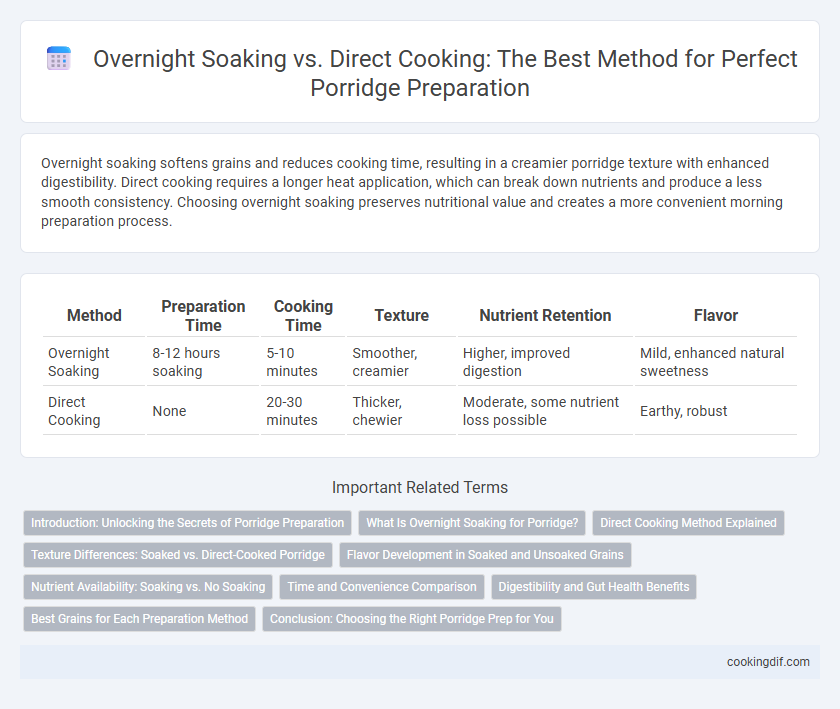Overnight soaking softens grains and reduces cooking time, resulting in a creamier porridge texture with enhanced digestibility. Direct cooking requires a longer heat application, which can break down nutrients and produce a less smooth consistency. Choosing overnight soaking preserves nutritional value and creates a more convenient morning preparation process.
Table of Comparison
| Method | Preparation Time | Cooking Time | Texture | Nutrient Retention | Flavor |
|---|---|---|---|---|---|
| Overnight Soaking | 8-12 hours soaking | 5-10 minutes | Smoother, creamier | Higher, improved digestion | Mild, enhanced natural sweetness |
| Direct Cooking | None | 20-30 minutes | Thicker, chewier | Moderate, some nutrient loss possible | Earthy, robust |
Introduction: Unlocking the Secrets of Porridge Preparation
Overnight soaking enhances porridge's digestibility by breaking down complex starches and reducing cooking time significantly, preserving more nutrients compared to direct cooking. Direct cooking provides a faster preparation method but often requires longer heat exposure, which can diminish certain vitamins and alter texture. Choosing between these methods impacts the porridge's nutritional profile, texture, and overall health benefits.
What Is Overnight Soaking for Porridge?
Overnight soaking for porridge involves immersing grains or oats in water or milk for several hours or overnight before cooking, which enhances nutrient absorption and reduces cooking time. This method softens the grains, making them easier to digest while retaining more vitamins and minerals compared to direct cooking. Soaking also allows enzymes to break down phytic acid, boosting the bioavailability of iron, calcium, and zinc in the porridge.
Direct Cooking Method Explained
The direct cooking method for porridge involves combining grains and water or milk directly in a pot and cooking over medium heat until the mixture thickens, typically taking 20 to 30 minutes. This method preserves the natural texture and flavor of the grains, allowing for immediate consumption without prior preparation. Direct cooking is favored for its simplicity and faster preparation compared to overnight soaking, making it ideal for quick and wholesome breakfast options.
Texture Differences: Soaked vs. Direct-Cooked Porridge
Overnight soaking softens grains by allowing them to absorb water fully, resulting in a creamier and more uniform porridge texture. Direct cooking often produces a porridge with a firmer bite and slightly grainier consistency due to less water absorption before heat application. Choosing soaking or direct cooking impacts the final texture, influencing the porridge's mouthfeel and digestibility.
Flavor Development in Soaked and Unsoaked Grains
Overnight soaking of grains enhances flavor development in porridge by allowing enzymatic activity to break down starches into simpler sugars, resulting in a naturally sweeter and more complex taste profile. Direct cooking without soaking preserves the grains' original nutty and earthy flavors but may result in a denser texture and less pronounced sweetness. Soaked grains also improve digestibility and contribute to an overall smoother mouthfeel, enriching the porridge experience.
Nutrient Availability: Soaking vs. No Soaking
Overnight soaking porridge grains enhances nutrient availability by reducing phytic acid and enzyme inhibitors, which otherwise limit mineral absorption. Direct cooking without soaking may result in lower bioavailability of essential nutrients such as iron, zinc, and calcium. Soaking also initiates enzymatic activity that breaks down complex compounds, making proteins and carbohydrates more digestible.
Time and Convenience Comparison
Overnight soaking of grains for porridge softens them, significantly reducing morning cooking time to just a few minutes, enhancing convenience for busy schedules. Direct cooking without soaking requires extended simmering, often 20-30 minutes, demanding more active preparation time and attention. Choosing overnight soaking optimizes meal prep efficiency, balancing texture and speed for a quick, hassle-free breakfast.
Digestibility and Gut Health Benefits
Overnight soaking of grains before cooking porridge significantly enhances digestibility by breaking down phytic acid and reducing anti-nutrients, which promotes better nutrient absorption. This process supports gut health by fostering beneficial enzymes and prebiotics that improve digestion and microbiome balance. Direct cooking without soaking may result in tougher textures and slower digestion, limiting these gut-friendly benefits.
Best Grains for Each Preparation Method
Whole oats and steel-cut oats are ideal for overnight soaking due to their firm texture and ability to absorb water gradually, resulting in a creamy consistency without cooking. Quick oats and instant oats suit direct cooking because their finely processed structure allows for rapid hydration and softening when exposed to heat. Barley and quinoa perform well with overnight soaking, enhancing digestibility and texture, while direct cooking maximizes the nutty flavor and tender finish of rolled oats.
Conclusion: Choosing the Right Porridge Prep for You
Overnight soaking enhances nutrient absorption and reduces cooking time, making it ideal for busy mornings and improved digestion. Direct cooking offers convenience for quick meal preparation, preserving more of the grain's natural texture and flavor. Selecting the right porridge preparation depends on your lifestyle, nutritional goals, and taste preferences for an optimal breakfast experience.
Overnight soaking vs direct cooking for porridge prep Infographic

 cookingdif.com
cookingdif.com